HMS Victory: The World's Oldest Warship Still In Commission
By: Rosemary Giles (warhistoryonline)

HMS Victory: The World's Oldest Warship Still In Commission
Undoubtedly one of the most famous ships in the world, the over-200-year-old HMS Victory had an incredible service history with the British.
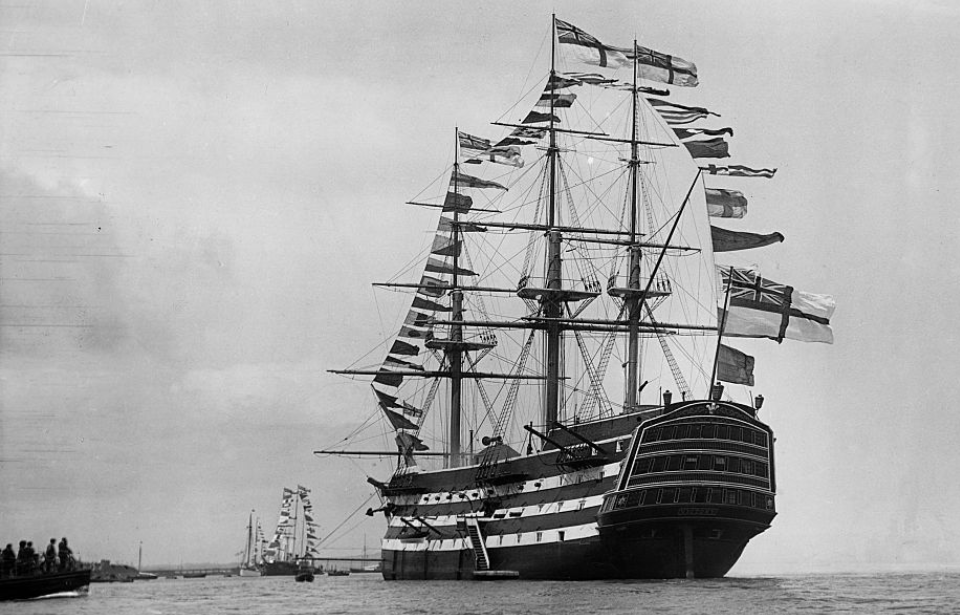
Photo Credit: Hulton-Deutsch Collection / CORBIS / Getty Images
At well over 200 years old, the HMS Victory is undeniably one of the most famous ships in the world. Serving as the flagship for Lord Horatio Nelson during the Battle of Trafalgar, she's been well-preserved, despite her age, thanks to the dedication of British citizens numerous times throughout her past.
Discover the fascinating - and lengthy - history of one of the most incredible ships ever commissioned by the British Royal Navy.
Construction of the HMS Victory
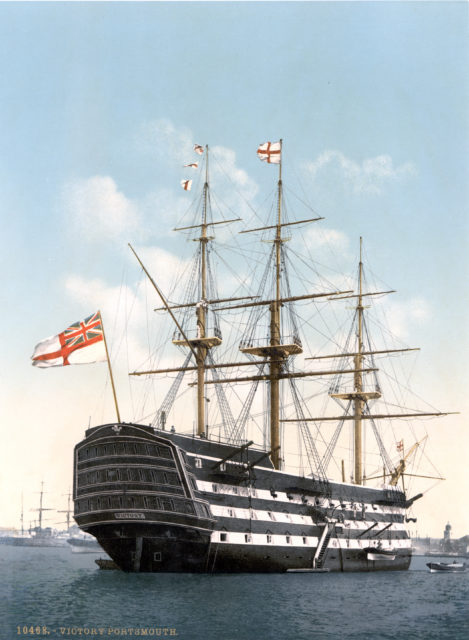
HMS Victory, 1900. (Photo Credit: Unknown Author / Wikimedia Commons / Public Domain)
The HMS Victory was built during the 18th century as one of 12 first-rate ships designed to carry at least 100 guns. Her keel was laid down on July 23, 1759, and she was given her name in October of the following year. The vessel's frame was constructed by 150 workmen, who used the wood of a whopping 6,000 trees, the majority of them oak.
At the time, the Seven Years' War was going in England's favor, so there wasn't a rush to complete construction. It wasn't until May 7, 1765 that Victory was finally launched.
A few problems soon became obvious. First, the ship's lower gunports were only 1.4 meters above the water, and she tipped slightly to the right. The latter problem was fixed, but it was determined that, if Victory was fighting in rough water, then the lower guns couldn't be used, as they would flood the vessel.
As the Seven Years' War was over by the time of her launch, Victory wasn't put into service until the American Revolution, sitting for years in the River Medway.
HMS Victory 's specifications
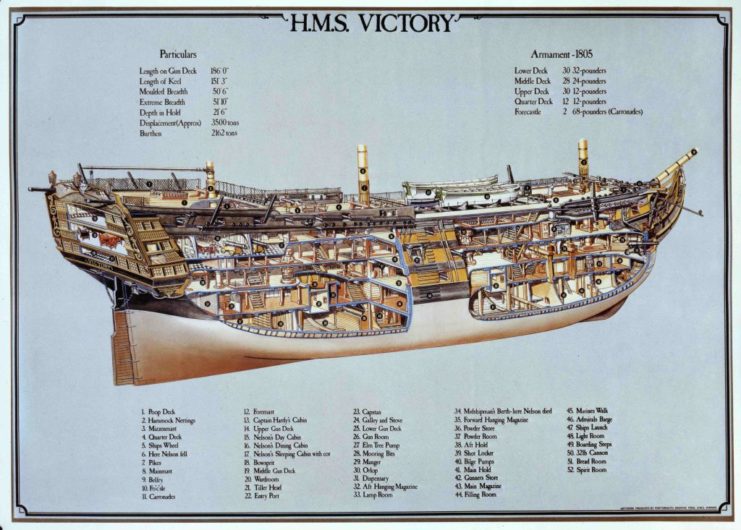 HMS Victory, as she was equipped in 1805. (Photo Credit: Photo12 / Universal Images Group / Getty Images)
HMS Victory, as she was equipped in 1805. (Photo Credit: Photo12 / Universal Images Group / Getty Images)
The HMS Victory was certainly a sizeable ship at 227 feet, six inches in length - her gundeck alone measured 186 feet. Her depth of hold was more than 21 feet, with a draught of just over 28 feet. Arguably the most visually impressive feature was her sails, and it's no wonder why - they totaled 6,510 square yards, allowing for a top speed of 11 knots. She could also hold a crew of roughly 850 men.
Victory 's armaments changed throughout the years, though they were always made up of various cast iron cannons. Initially, she had thirty 42-pound cannons on the lower deck, twenty-eight 24-pound long guns on the middle deck, thirty 12-pound cannons on the upper deck, and 12 six-pound cannons split between the quarterdeck and the forecastle. The 42-pound ones were swapped back and forth with 32-pound cannons, depending on what was available at the time.
The HMS Victory makes a name for herself in combat
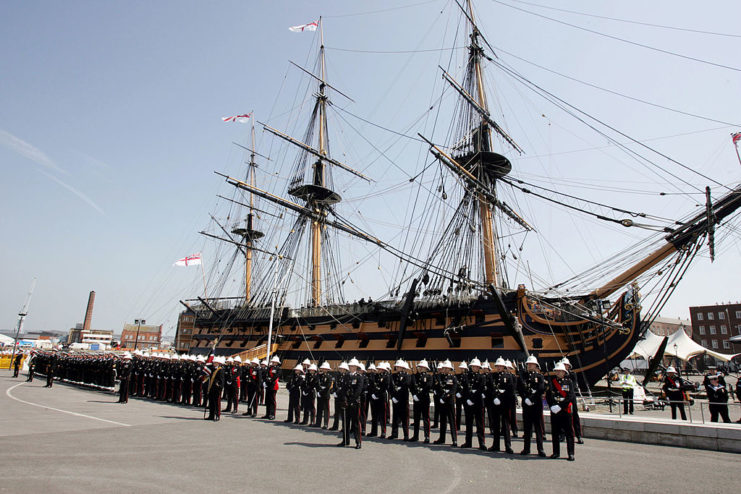
British Royal Navy sailors from the HMS Victory stand guard in front of the ship for the 200th anniversary of the Battle of Trafalgar, June 2005. (Photo Credit: Jamie Wiseman / AFP / Getty Images)
The HMS Victory quickly became known as an excellent vessel at sea, taking on the role of flagship for many well-known British admirals. She was used during the First and Second Battles of Ushant, the Siege of Gibraltar and the Battle of Cape St. Vincent.
Following this last engagement, she was sent back to England to be assessed for seaworthiness, and naval architect Sir Robert Seppings found Victory had significant weakness in her stern. As such, she was declared unfit for service and left in the Chatham Dockyard, until she was turned into a hospital ship for French and Spanish prisoners of war (POWs) in December 1798.
Ultimately, the decision was made to recondition Victory and bring her back into service, after the HMS Impregnable (1810) ran aground, leaving the British Admiralty without a high-quality, three-decked ship. As well as fresh paint, four gun ports were added, her magazine was lined with copper and the figurehead was replaced.
Lord Horatio Nelson
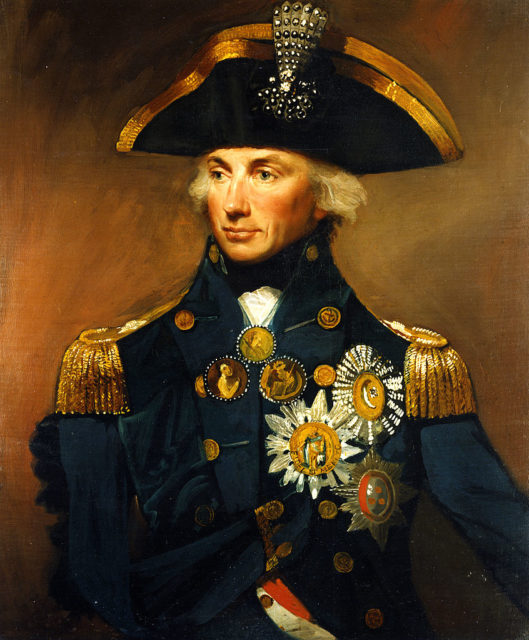
Lord Horatio Nelson, 1798. (Photo Credit: The Print Collector / Getty Images)
When her remodeling was complete, the HMS Victory was transferred to then-Vice-Adm. Horatio Nelson, who raised his flagon May 18, 1803, making Samuel Sutton captain. Nelson was the commander-in-chief of the Mediterranean Fleet and sent much of his vessels, including Victory, to blockade the French for 18 months. Under Adm. Pierre-Charles Villeneuve, the enemy ships escaped the British in March 1805.
The fleet gave chase, traveling to the West Indies. Nelson, aboard Victory, waited for them to leave Cadiz Harbor and sail into the Mediterranean. What ensued was the most famous of Victory' s engagements: the Battle of Trafalgar. It took place off of Cape Trafalgar against the same French and Spanish fleet the British had been chasing during the previous months.
Battle of Trafalgar
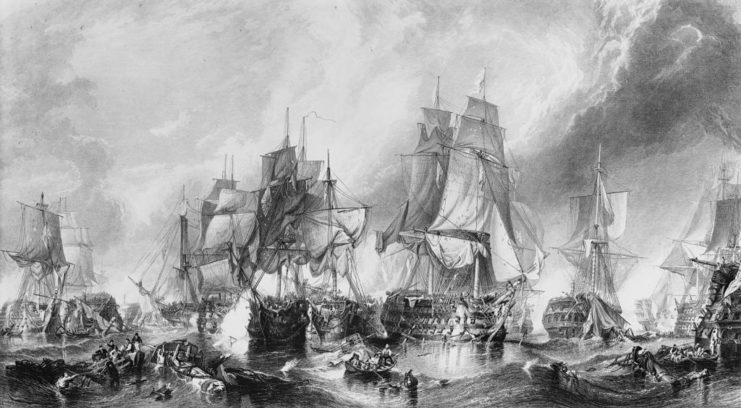
Redoutable (1795) engaging the HMS Victory during the Battle of Trafalgar, October 1805. (Photo Credit: Hulton Archive / Getty Images)
Before the battle broke out, Lord Nelson had the HMS Victory use flag signals to display his most famous line, "England expects that every man will do his duty." He then commanded his fleet of 27 ships to separate into two columns, forging forward to break the enemy line. Although conditions weren't quick, they were able to reach and engage the belligerents, with Victory taking on two vessels.
It seems only appropriate that the English flagship would be the one to take on her French counterpart, Bucentaure, as well as Redoutable (1795). Victory's guns tore a hole in the side of the former, and the amount of cannon fire caused between 300 and 450 casualties aboard the French vessel.
A sniper positioned on the mast of Redoutable managed to deliver a fatal shot to Nelson, who died before the battle concluded. Trafalgar was a win for the British, however, and Nelson's men carried the admiral's body home in a vat of liquor.
The HMS Victory is taken out of the fight
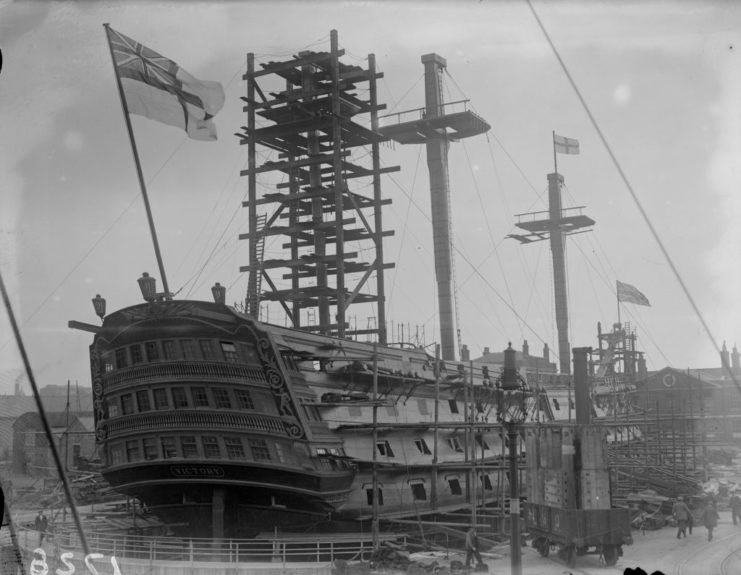
HMS Victory, 1926. (Photo Credit: Fox Photos / Getty Images)
The HMS Victory sailed for a few more years, to help with the British continental blockade during the Napoleonic Wars. Despite her impressive display at Trafalgar, the Admiralty decided shewas too old to be used any longer. She was demoted from first to second-rate, and used as a troopship, a floating depot and, finally, a prison ship.
As her condition worsened, Victory was taken to Portsmouth Harbour, where she served as the flagship for the port admiral, a non-sailing role. By 1831, it was decided that her time had come to an end and she was to be broken up and used to repair other vessels.
This, however, didn't sit well with the public. After significant discontent, Victory was opened to tours which, inadvertently, made her condition worse. On numerous occasions, she almost sank into the harbor, once because she was hit by the HMS Neptune (1874). Another was the result of the vessel springing a leak
Save the Victory Campaign
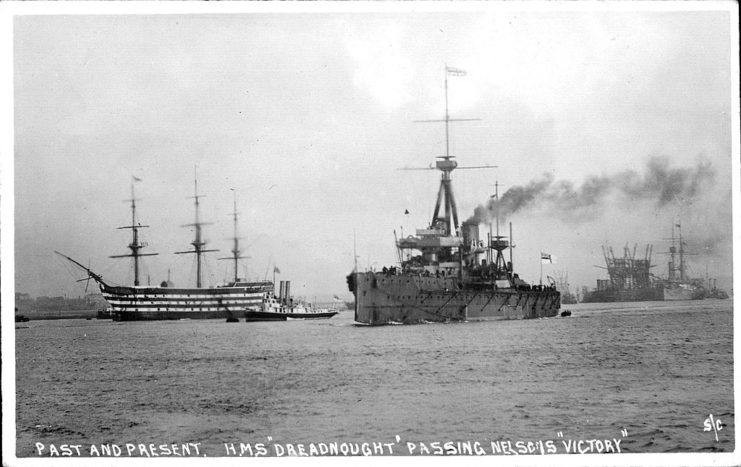 HMS Dreadnought (1906) passing the HMS Victory. (Photo Credit: Arkivi / Getty Images)
HMS Dreadnought (1906) passing the HMS Victory. (Photo Credit: Arkivi / Getty Images)
By 1886, the HMS Victory was in such bad shape that Sir Edward Seymour declared, "A more rotten ship than she had become probably never flew the pennant. I could literally run my walking stick through her sides in many places." A few years later, another observer called her condition "nothing short of an insult."
In 1921, the vessel was saved yet again by the public, who started the Save the Victory C ampaign. Thanks to the outcry, as well as a sizeable donation from Sir James Caird, Victory was taken to a drydock and restored to how she looked under the command of Lord Nelson. It took years for the work to be completed, and she was only made worse by the Luftwaffe dropping a bomb on her. It wasn't until the 200th anniversary of the Battle of Trafalgar, in 2005, that she was finally finished.
Now, Victory is open daily to tourists, and continual efforts are being made to ensure this doesn't cause ongoing problems like it did in the past. As of May 2022, there was more major conservation work underway, in order to preserve this impressive historic flagship.
No politics, no religion, no instagrams, and commentary must be civil. The ToS and the CoC will be enforced, and anything that the administrator deems to be offensive will be deleted. YouTubes, videos and images that the administrator is unable to open must be described and explained or they will be deleted.


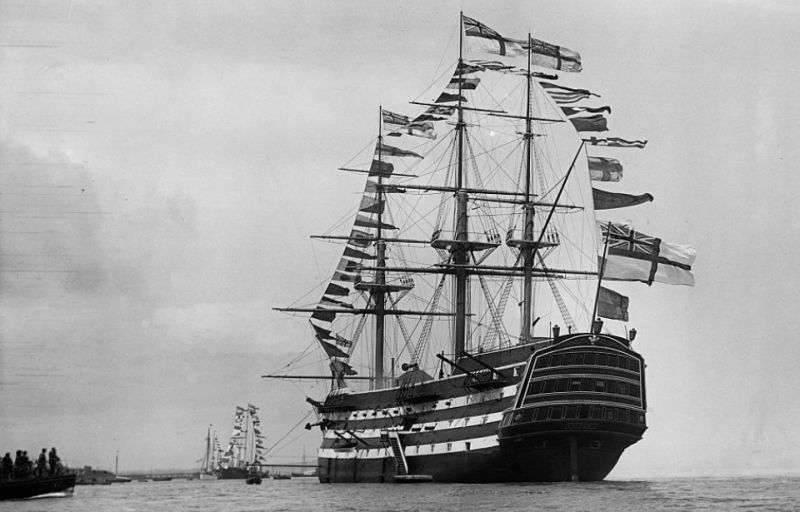


That is "one hell of a ship" with an amazing history.
I toured the Victory a few years ago. The standing rigging was missing. All that was there was the bottom half of the masts kind of like the 1926 picture in the article. It seems like she may need almost continuous maintenance to keep her afloat. There's a small brass medallion in the deck where Adm. Nelson was standing when he was shot. I recommend going to see it if you're into this kind of thing. It's pretty cool.
I don't think it needs to remain afloat - the article indicated it was in drydock. When I was in England I was never anywhere near Portsmouth, but if I had been I definitely would have wanted to board that ship. After all, I DID board the Constitution so it would only be fair to give both sides a chance.
She was afloat when I was there. I think it was 2020.
REALLY afloat or just appearing to be. I checked these two web sites, both dated 2020:
HMS Victory "afloat" again for the first time in nearly 100 years
LI NK -> HMS Victory "afloat" again for the first time in nearly 100 years | Newsroom | BAE Systems
and
HMS Victory Figuratively Afloat in the Portsmouth Historic Dockyard
When HMS Victory went into drydock in the Portsmouth Historic Dockyard in 1922, she was supported by 22 steel cradles. In the almost 100 years that she has remained on the dock, the historic ship’s 3,500-tonne hull had been to slowly collapse in on itself. To save the ship, the cradles have been replaced by an innovative system of 134 “props” that replicate the loads HMS Victory would have encountered while afloat. The ship will now be, at least figurately, floating in the drydock.
LINK -> HMS Victory Figuratively Afloat in the Portsmouth Historic Dockyard
The hull has not been in water for more than a century.
For ten years, I was an independent management consultant. I worked with small and medium businesses. The name of my company was "Victory Consultants".
In all those years, only one client caught the significance of the name. I arrived in the entry hall, where one of those "Welcome Mr Whatever" signs waited for me, "Mr Nelson, Victory Consultants".
Another arrival almost screeched; "Mais! Il se moque de nous!" (Hey! He's making fun of us!)
My ancestors are mainly Danish. US immigration screwed up the spelling of the name of my great-grandfather, Andreas Nielsen.
It shouldn't bother you much - "Nelson" is a name to be proud of.
Twenty years ago, we went to Denmark, to Jutland. We found some distant cousins. It seems that Andreas had left town two steps ahead of a very angry father of a very pregnant girlfriend.
Andreas went back to Denmark as an old man. He did not warn that he was coming - just telephoned from the railroad station, for someone to come get him. He lived on, messing up his family's lives, for another twenty years.
You made me burst out laughing with why he left town.